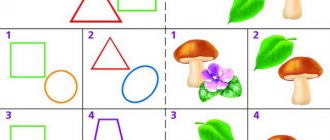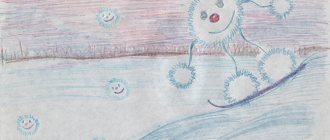Non-traditional appliqué techniques
Non-traditional appliqué techniques
And its influence on the development of creative abilities of preschool children.
Educator: Yu. A. Piterova
Translated from Latin, appliqué means “attachment.” This is one of the types of visual activity.
- This activity helps the development and formation of visual perceptions, imagination, spatial concepts, and memory.
- Such personality traits as perseverance, focus, accuracy, and hard work are formed.
- A whole range of graphic and painting skills is acquired.
- The ability to analyze objects and phenomena of the surrounding world is formed.
- Iso activity is important for the development of fine motor skills of the fingers, their muscles, and coordination of movements.
Visual activity is of great importance for solving problems:
- Mental education. The stock of knowledge about objects of the surrounding world, sizes, variety of shades of colors expands, mental operations, comparison, and generalization are formed. Speech develops, vocabulary is enriched, and coherent figurative speech is formed. Such qualities as inquisitiveness, initiative, mental activity, and independence are formed.
- Sensory education. Direct, sensitive acquaintance with objects and phenomena, with their properties and qualities.
- Moral education. Art activities (application) cultivate moral and volitional qualities: finishing what is started to the end, studying with concentration and purpose, helping a friend, overcoming difficulties, etc.
- Labor education. This type of activity combines mental and physical activity, the ability to handle scissors, use a brush and glue, and prepare a workplace; all this requires physical strength and work skills.
- Aesthetic education. The sense of color arises from the perception of beautiful color combinations, the sense of rhythm arises from the rhythmic arrangement of parts of objects. A sense of proportion arises with the constructive integrity of the image, and children gradually develop artistic taste.
The application can be:
- Subject-based, consisting of individual images. It's best when it's a large item.
- Plot-based, depicting certain events. The details are not arranged “in a row,” what looks closer is larger, what is smaller looks further away.
- Decorative, including ornaments and patterns. It is characterized by a ribbon and central-radial composition
Kindergarten teachers tend to use the following techniques for teaching children appliqué:
- Patterns of various geometric shapes and plant details cut out of colored paper, arranging them in a certain rhythm.
- Compose an image of an object from colored paper in separate parts to depict the plot.
- Master various techniques for obtaining parts for appliqué from paper: cutting, tearing, weaving.
- Create an image of an object using the origami technique.
Non-traditional appliqué techniques
- Broken applique. Gives texture to the image.
Overlay applique
- A multi-color image, where each subsequent detail is smaller in size than the previous one.
Modular application
- Mosaic - gluing many identical shapes onto a base.
Symmetrical applique
- The workpiece is folded in half, holding the fold and cutting out half of the image.
Ribbon applique.
- The result is a lot of identical images, scattered or interconnected.
Silhouette applique
- Accessible to children who are good with scissors.
Quilling
- Paper rolling is the production of compositions from long and narrow strips of paper twisted into spirals.
Trimming
- Creating three-dimensional images with a “fluffy” effect.
Collage
- Gluing onto the base objects and materials that differ in color and texture.
Origami
- Folding paper figures.
Napkin applique
- Ample opportunities for creativity.
Corrugated paper applique
- Bright colors help create original works.
Fabric applique
- A type of embroidery. The applique is secured either by sewing or gluing.
Cereal application
- Perfectly develops fine motor skills of the fingers.
Straw applique
- It is made like a paper applique.
Application from dried plants
- Floristry is fascinating, interesting, develops creativity, thinking, observation, and hard work.
By creating beautiful applications with their own hands and seeing the result of their work, children experience positive emotions.
Working with paper and other materials allows children to show patience, stubbornness, imagination and taste. The more complete and varied a child’s activities are, the more successful the child’s development is, the more potential opportunities and first creative manifestations are realized.


